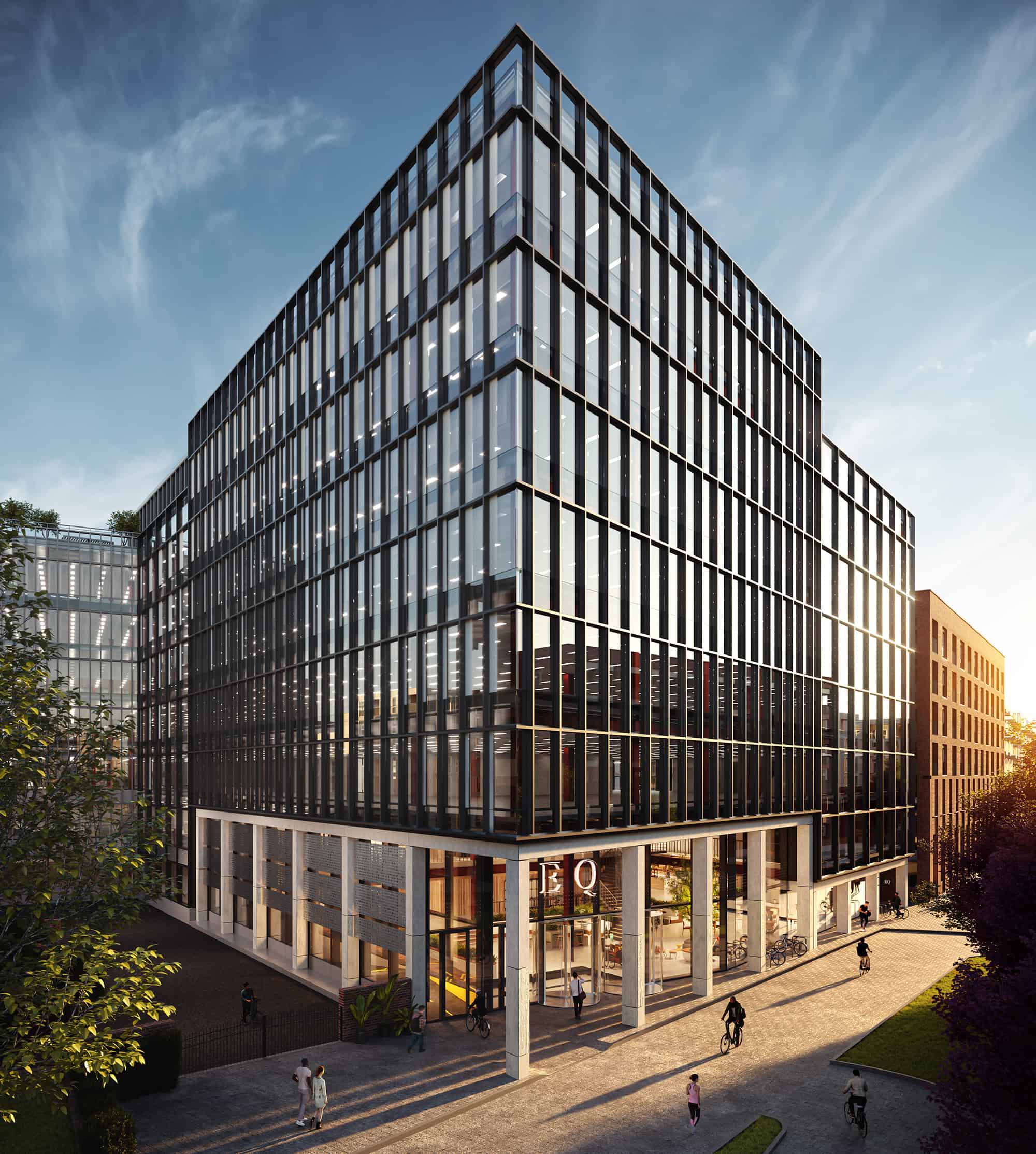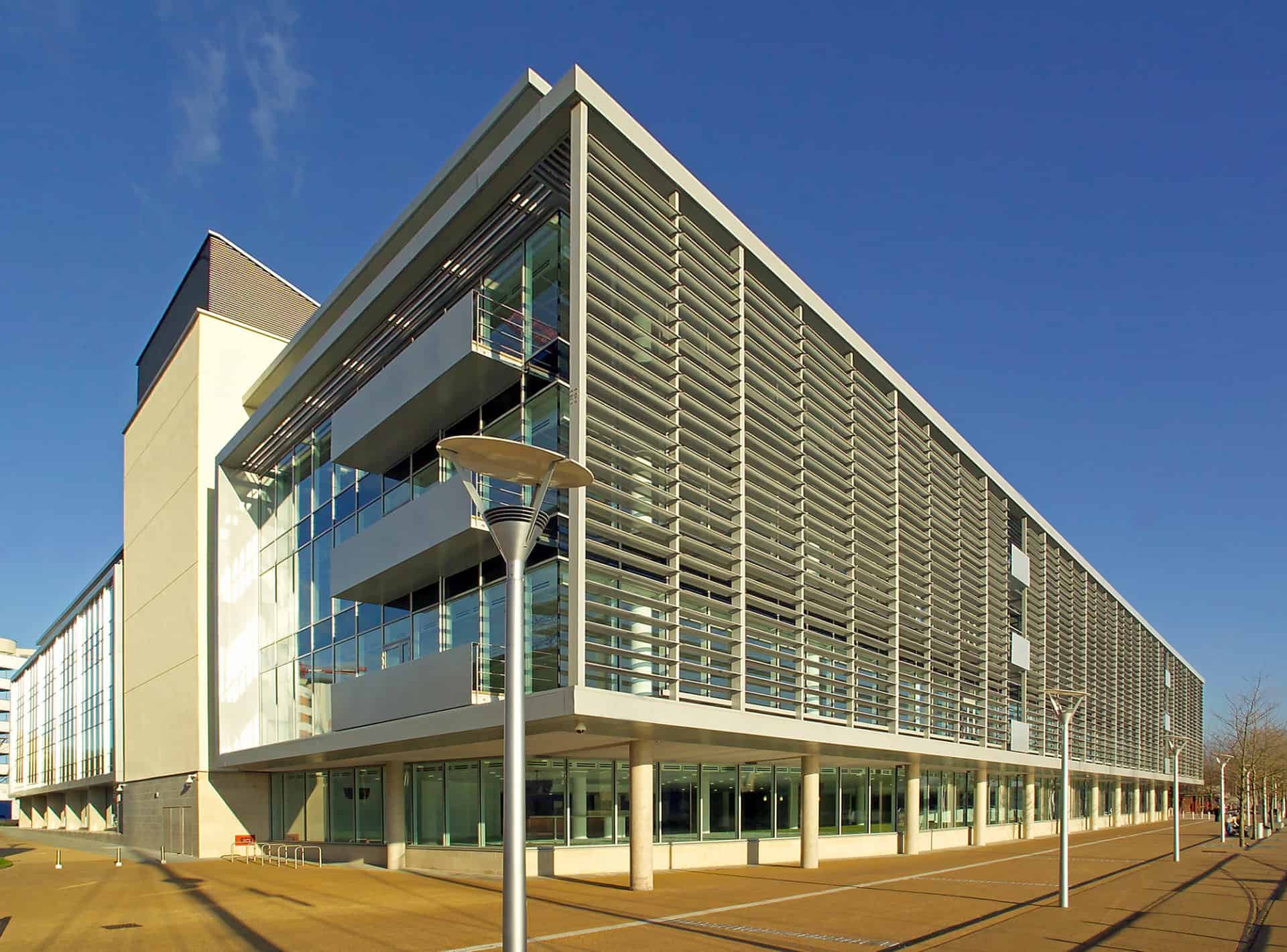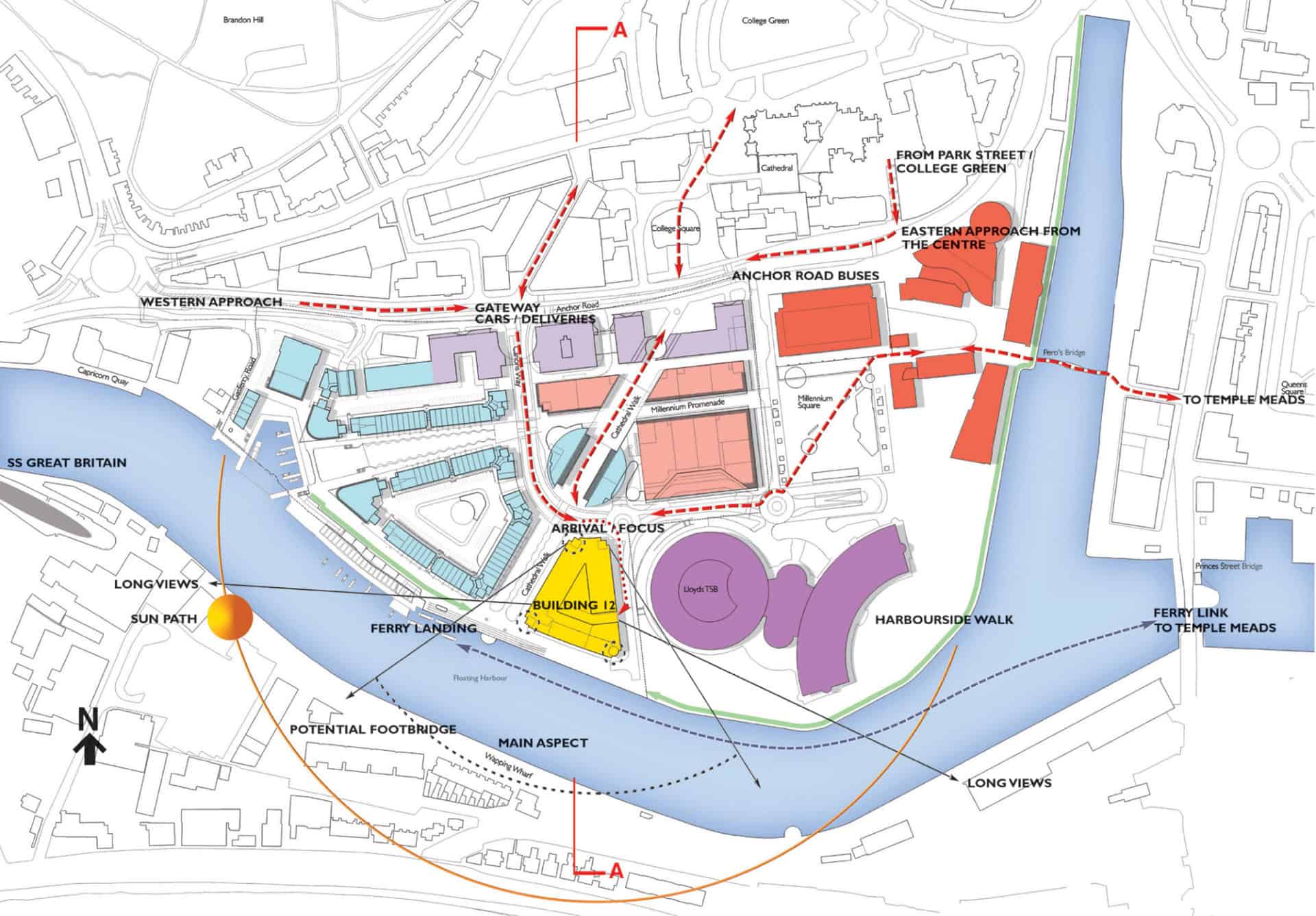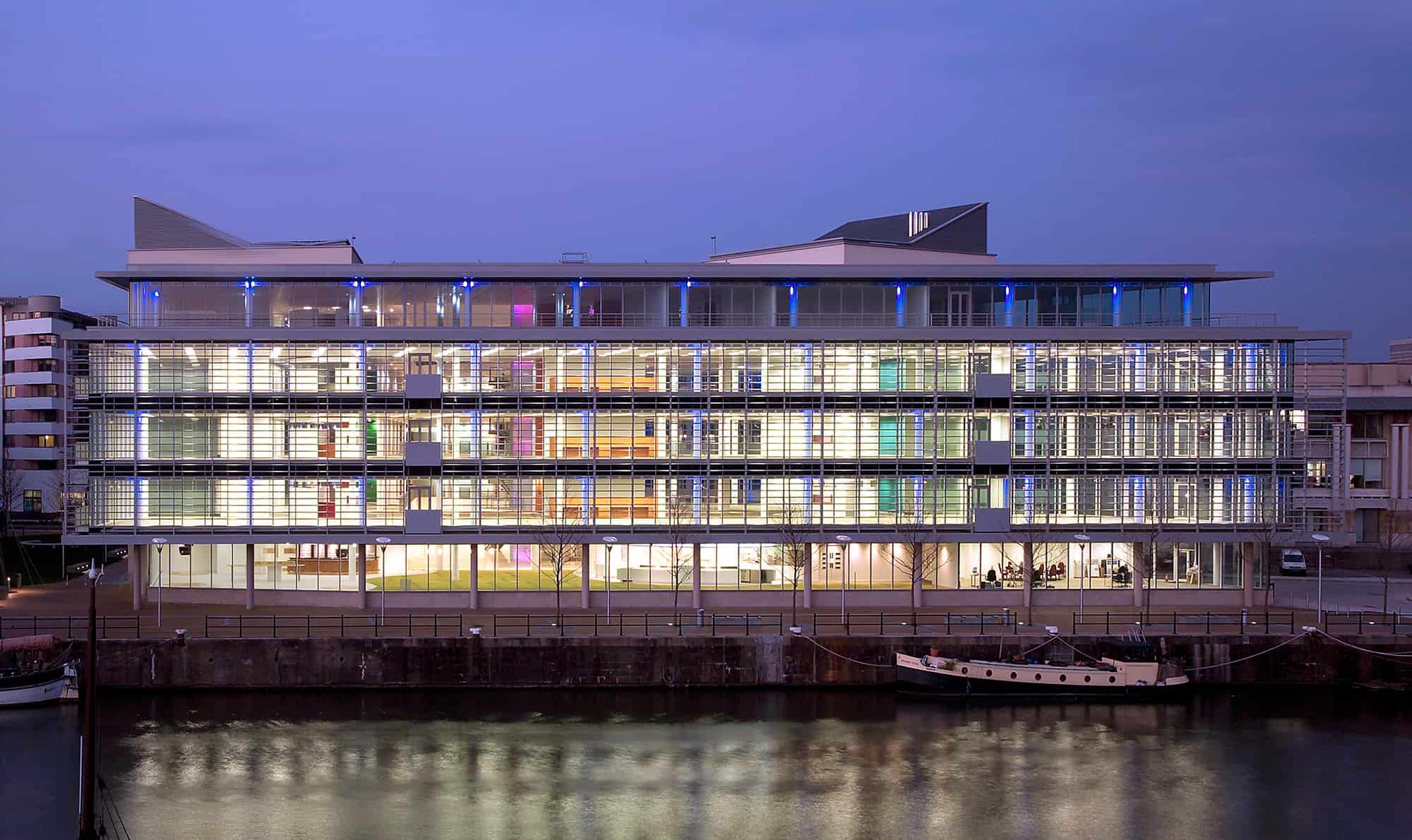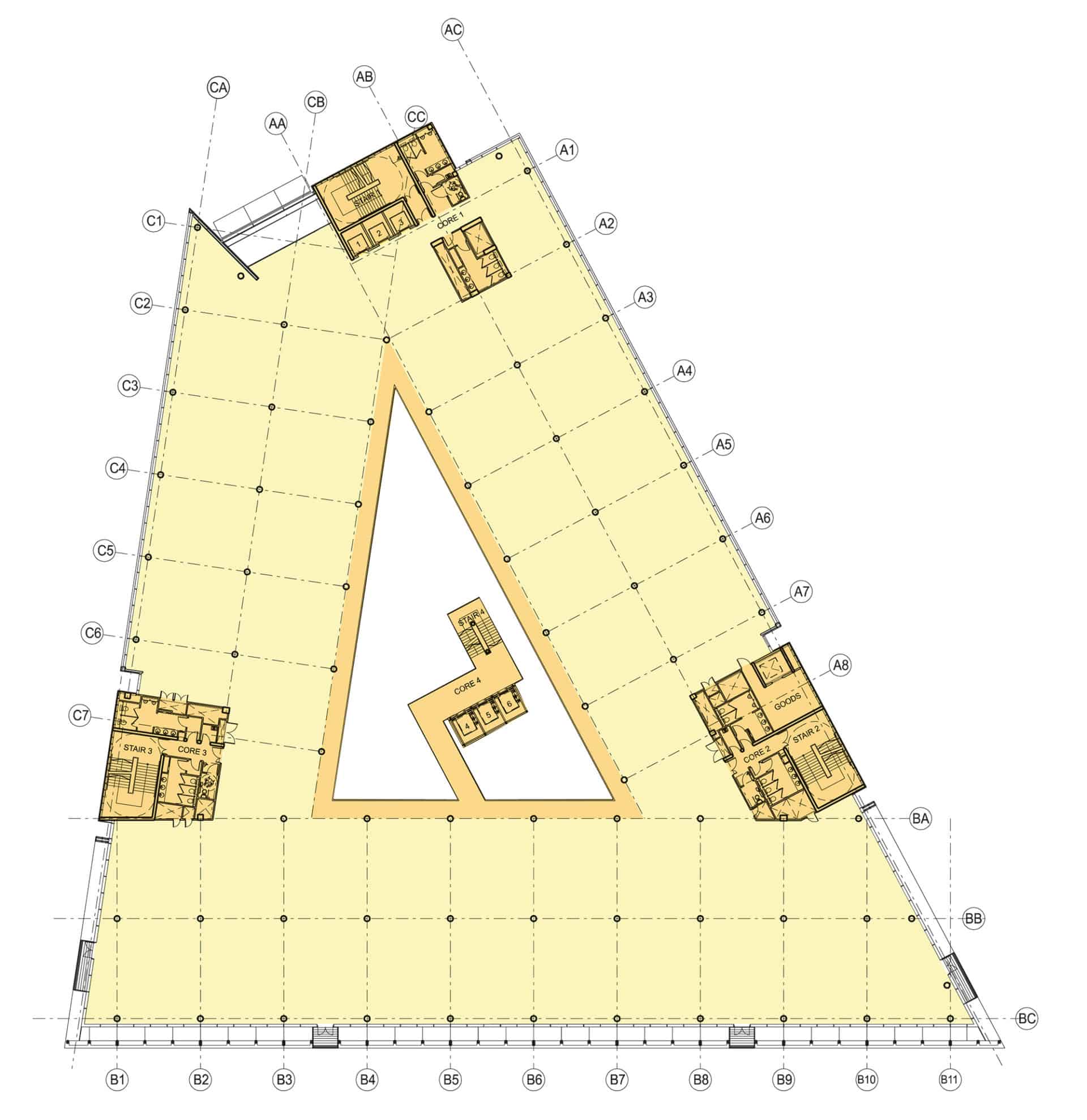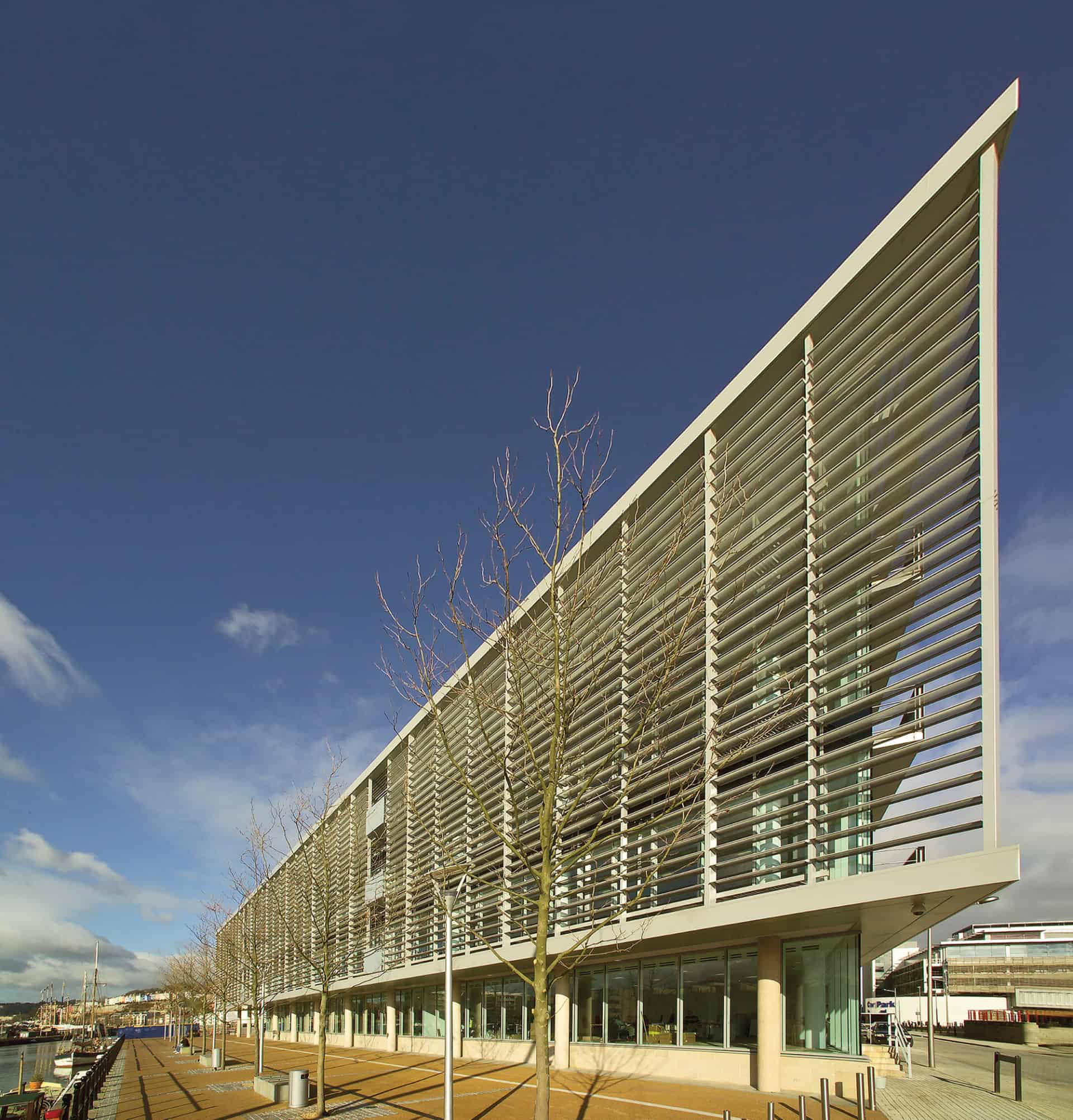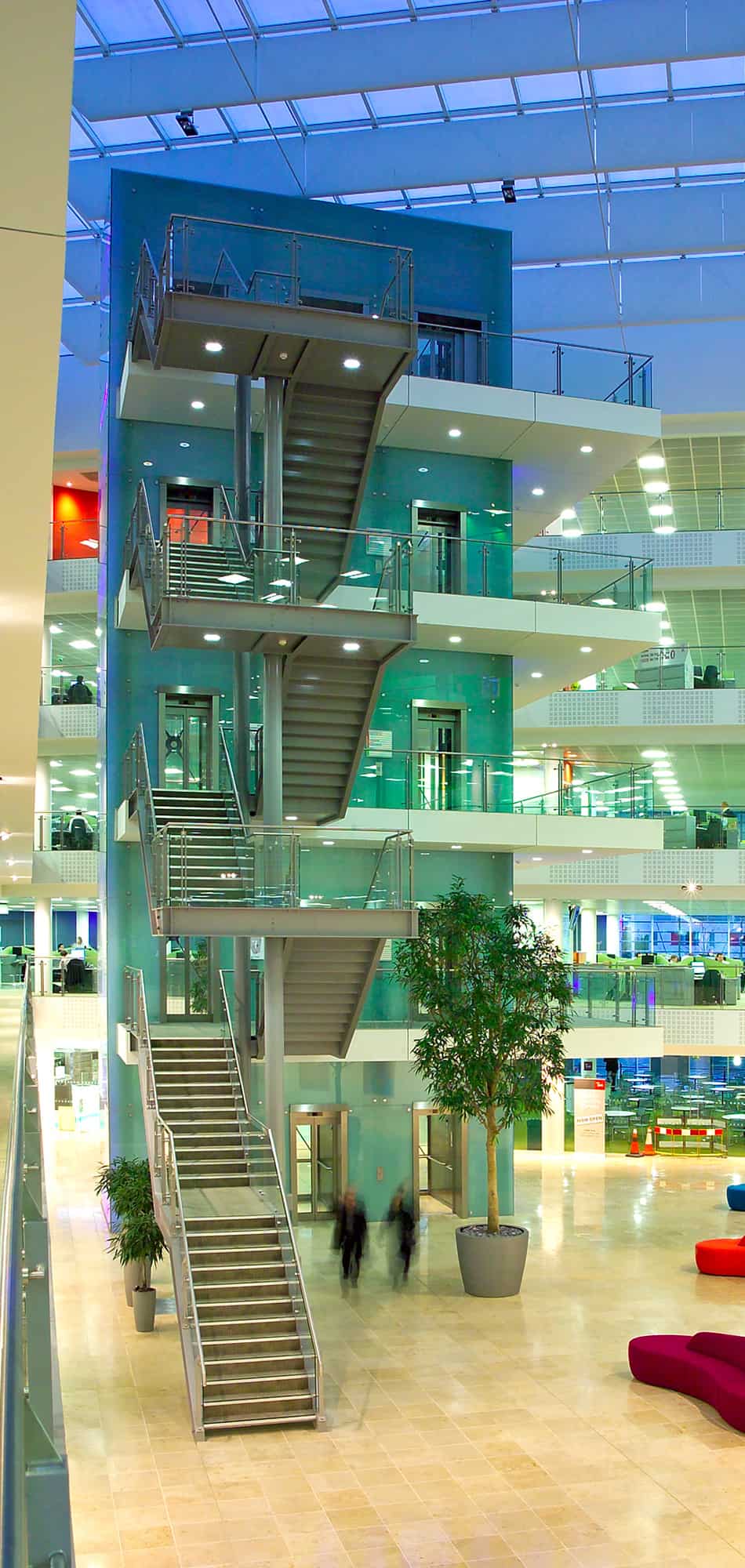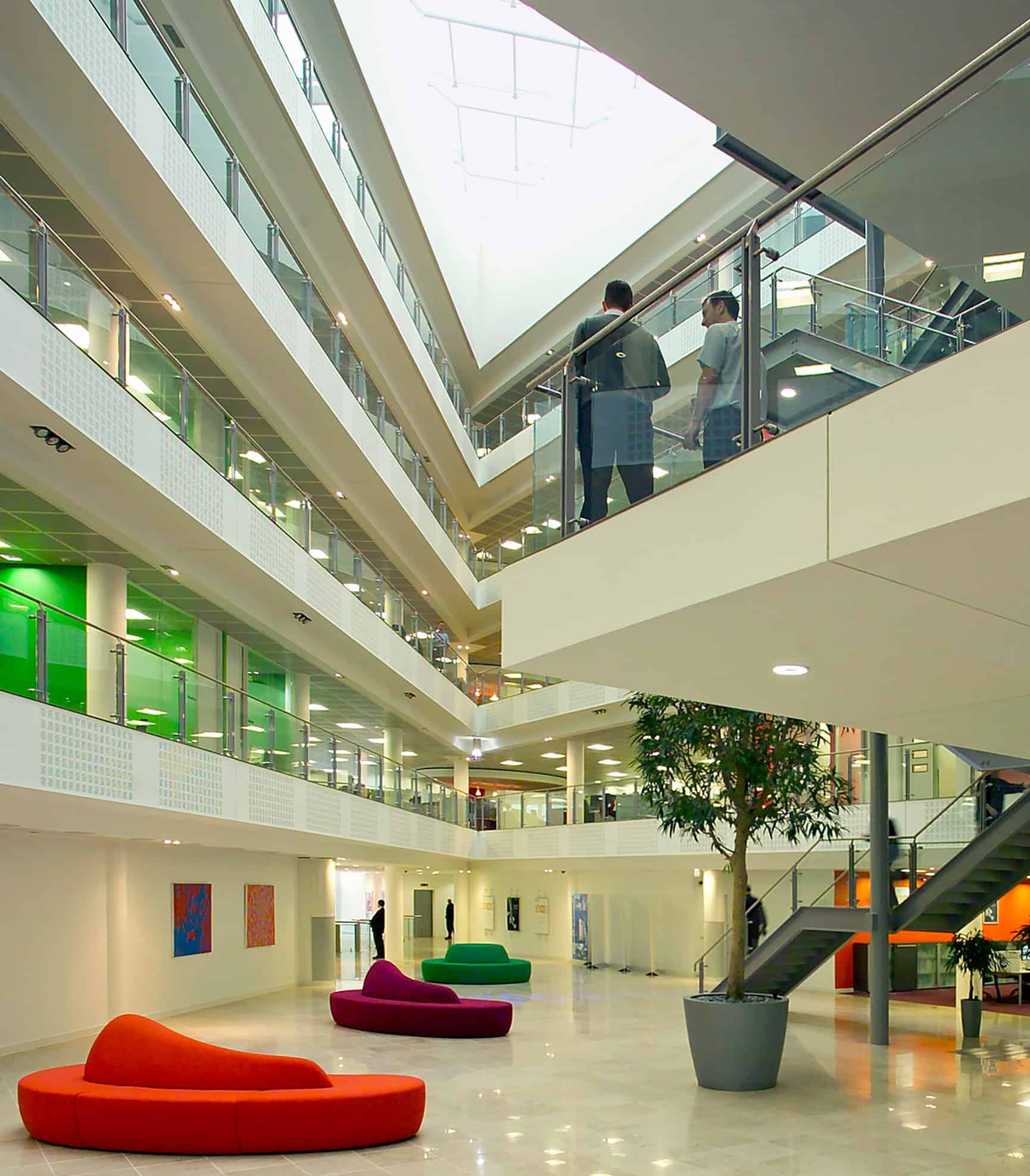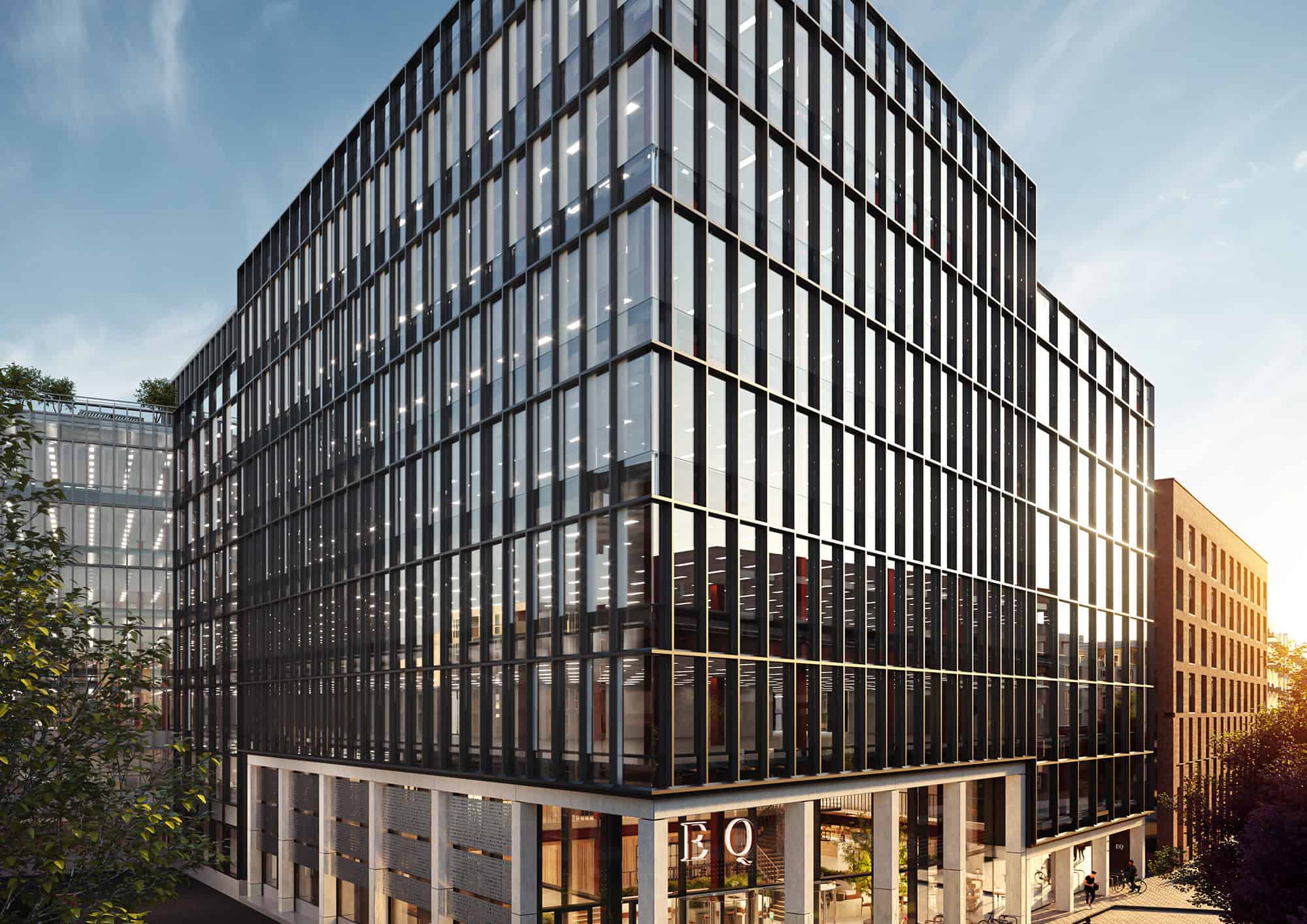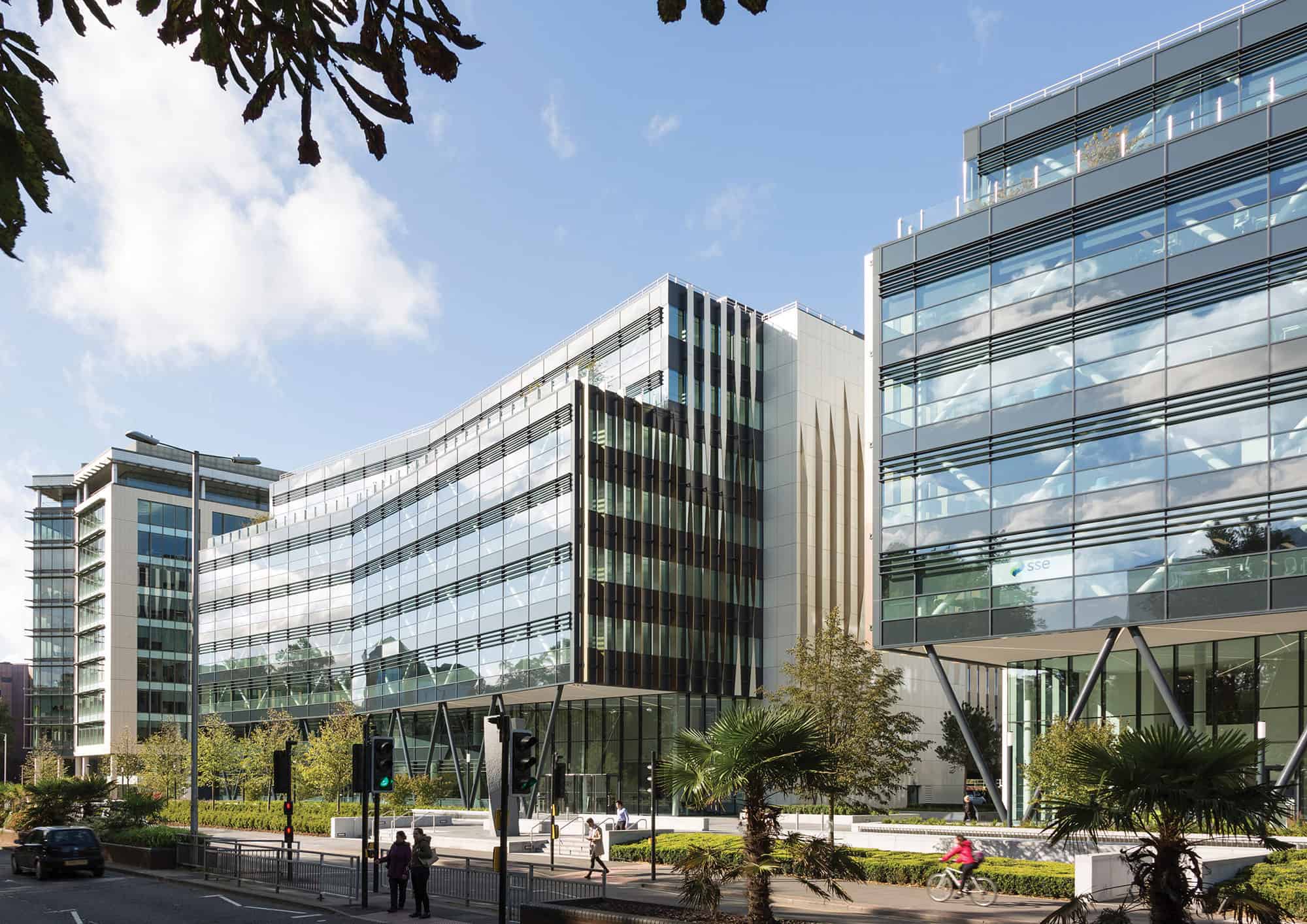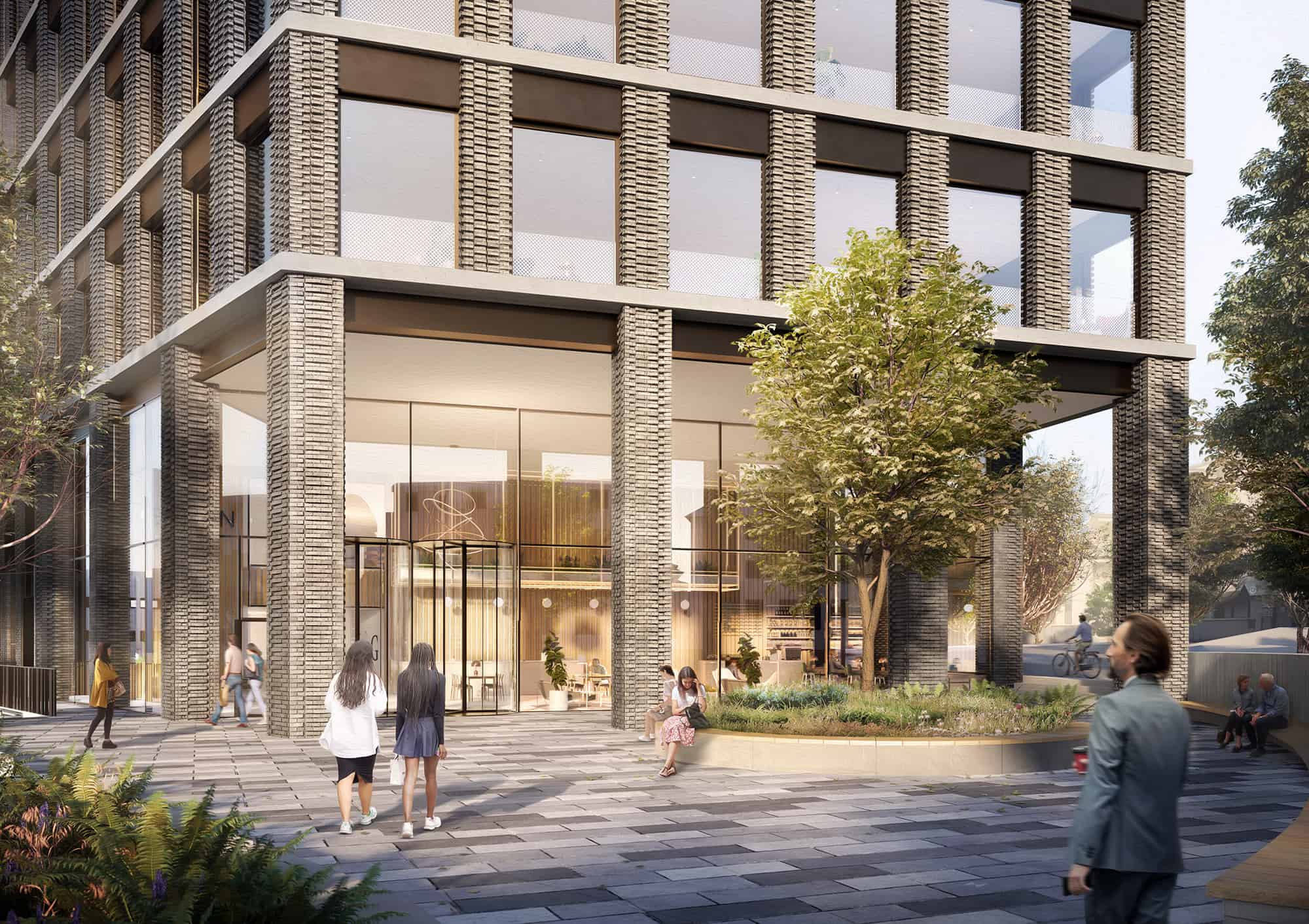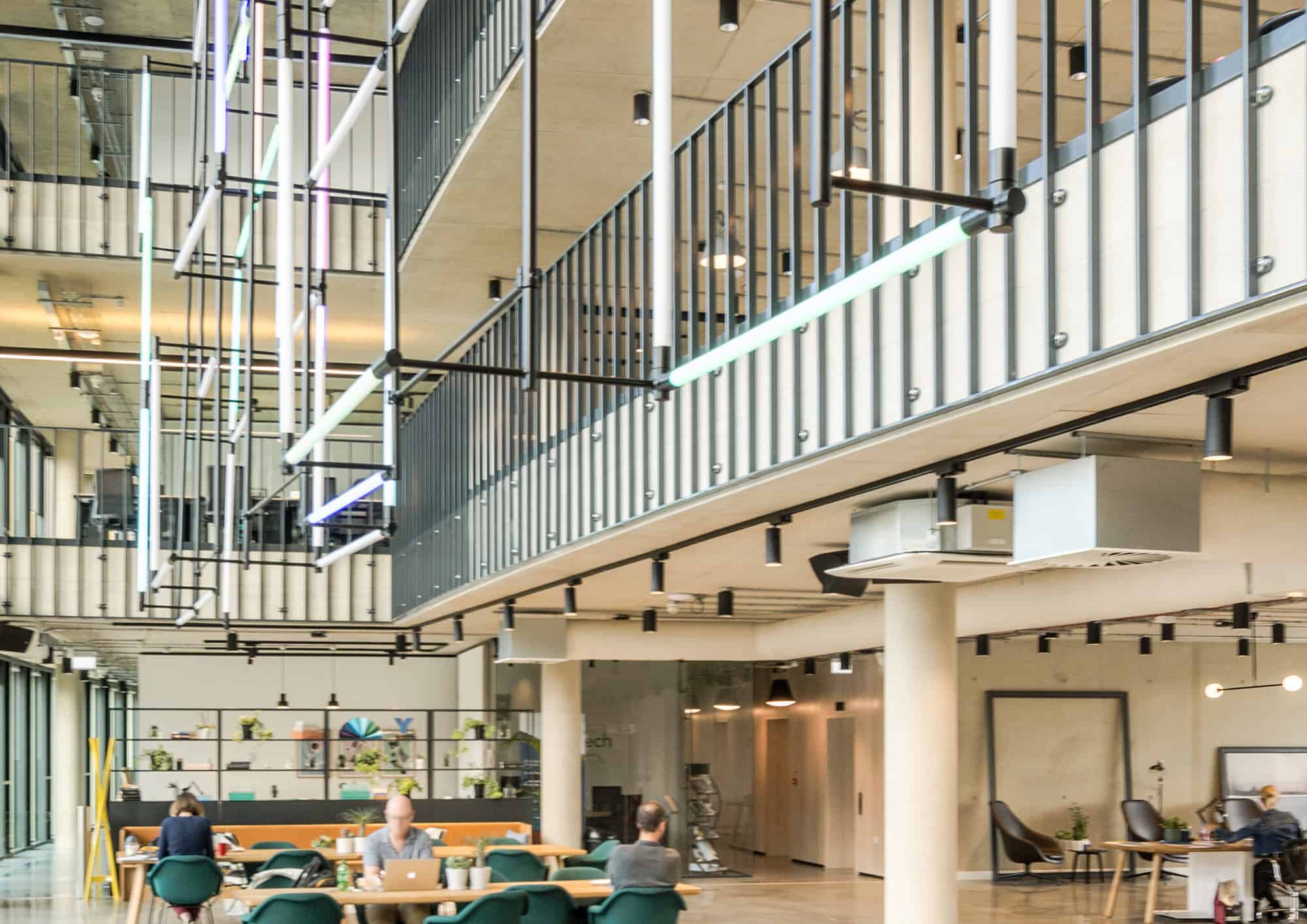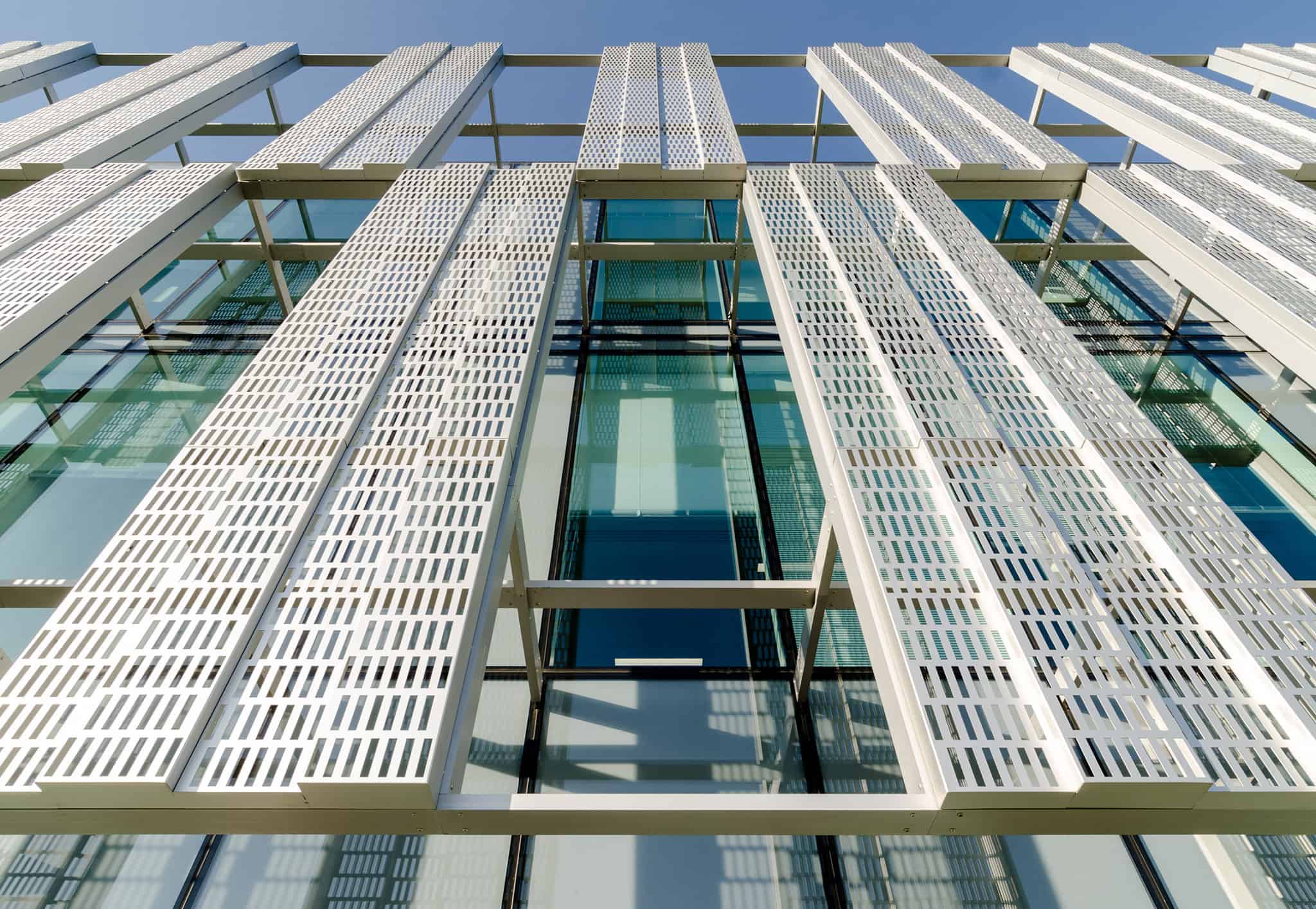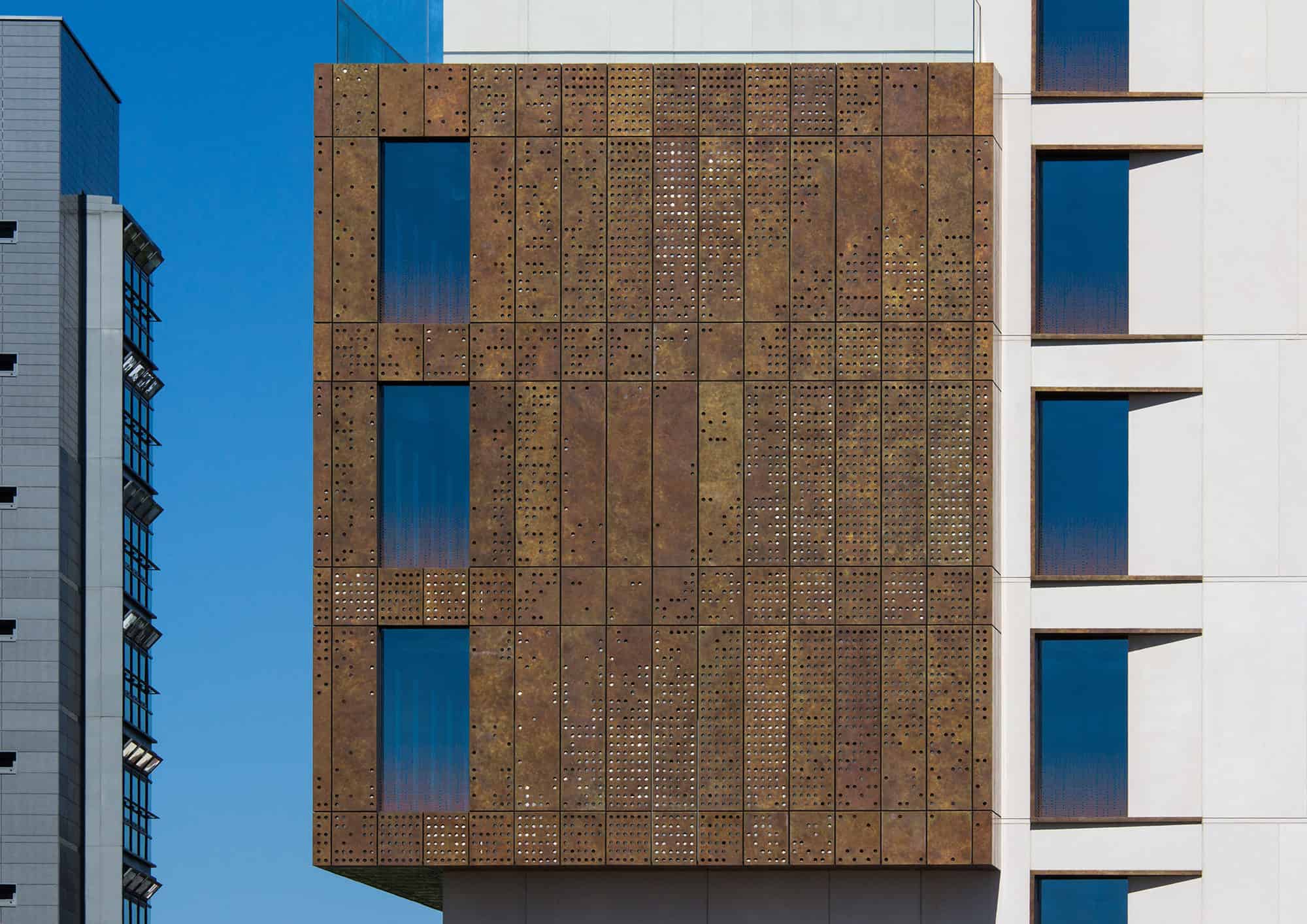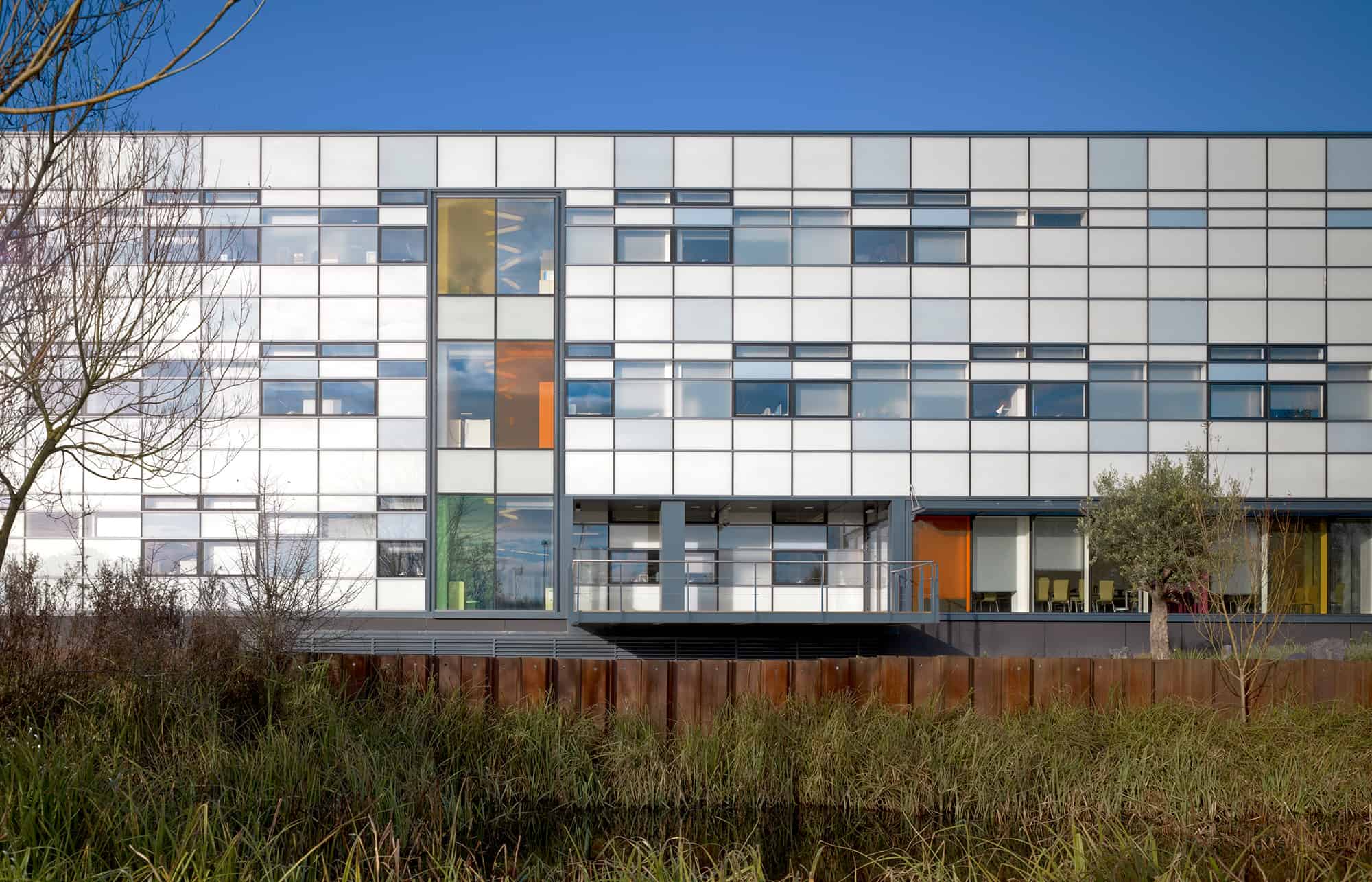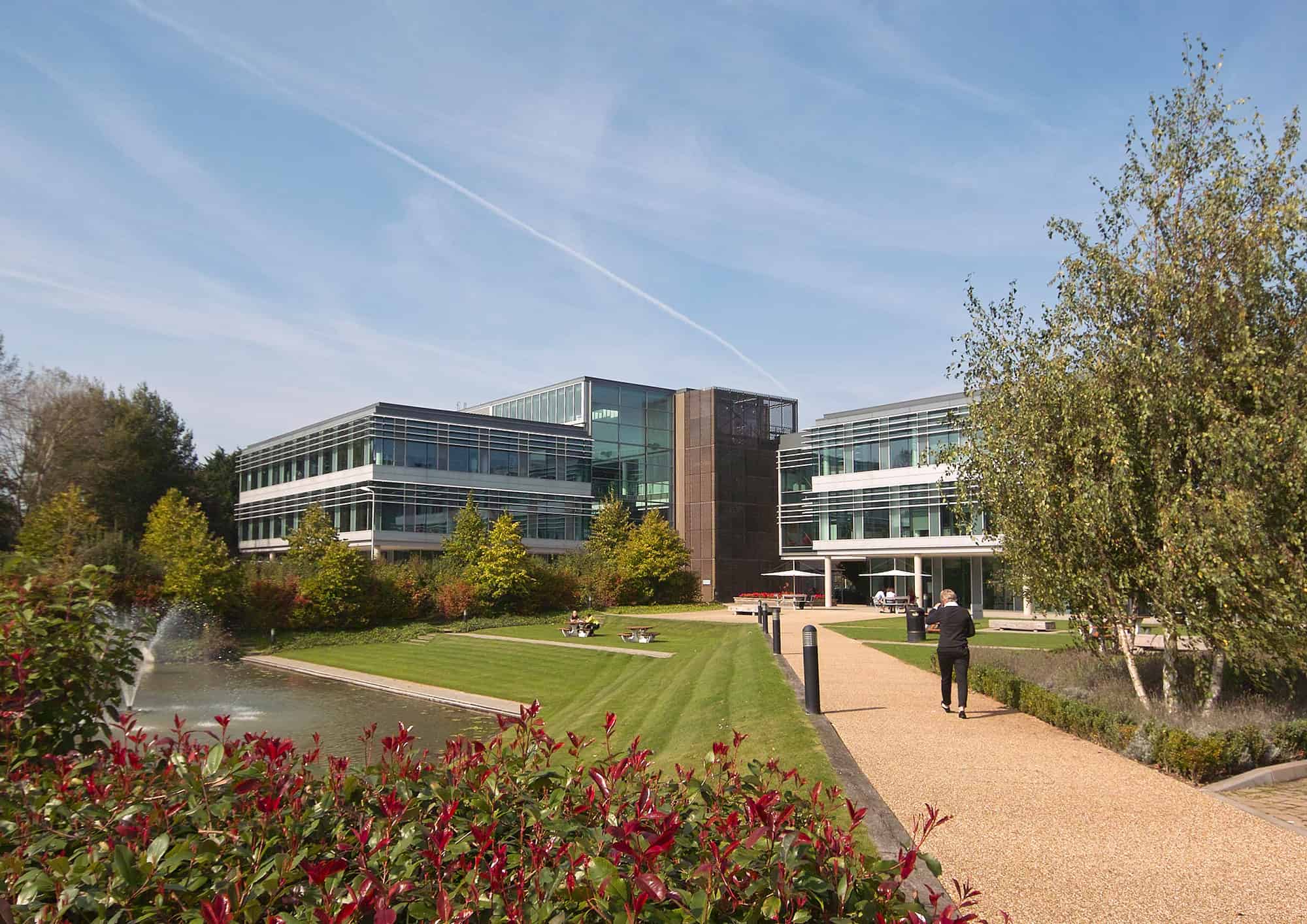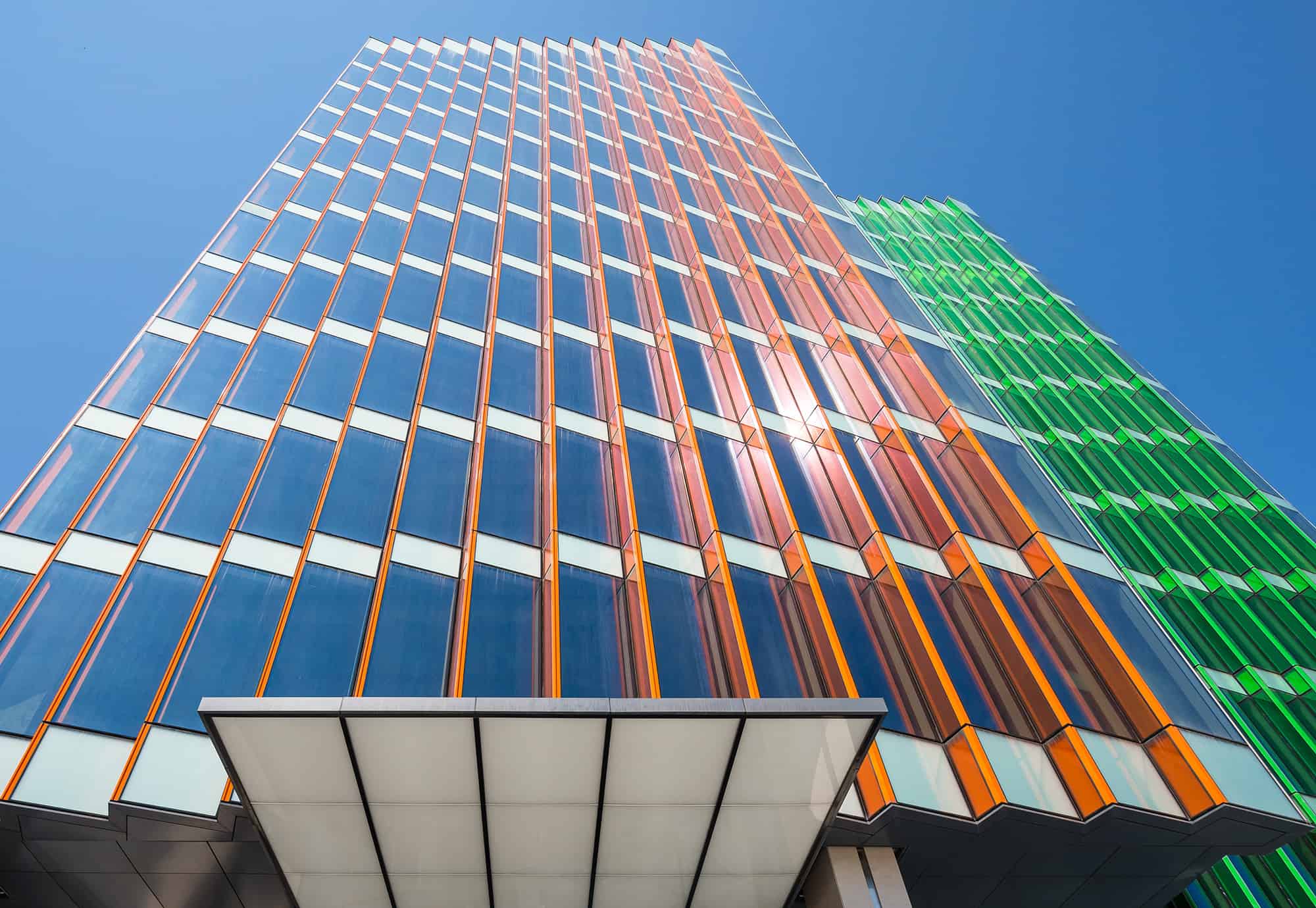UK
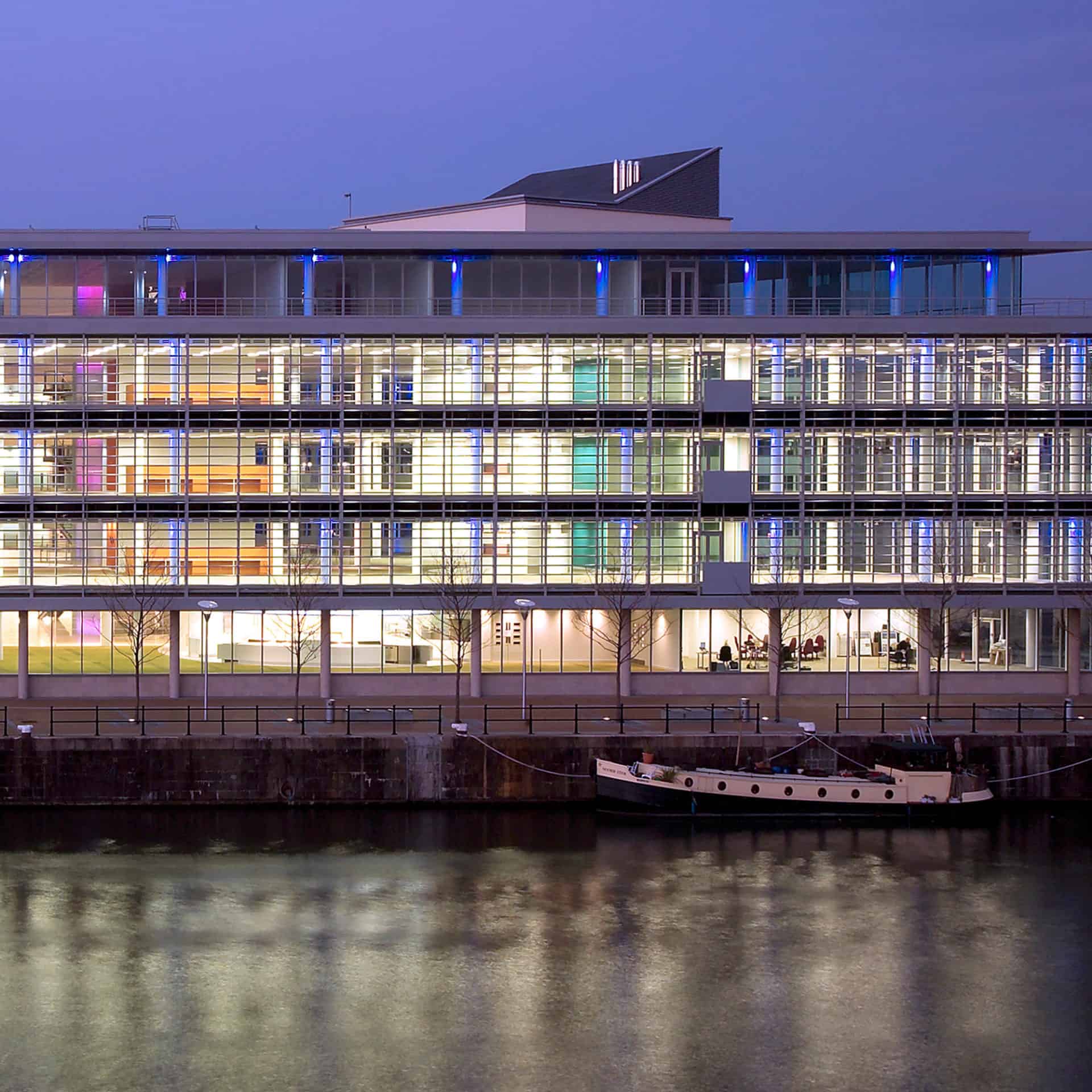
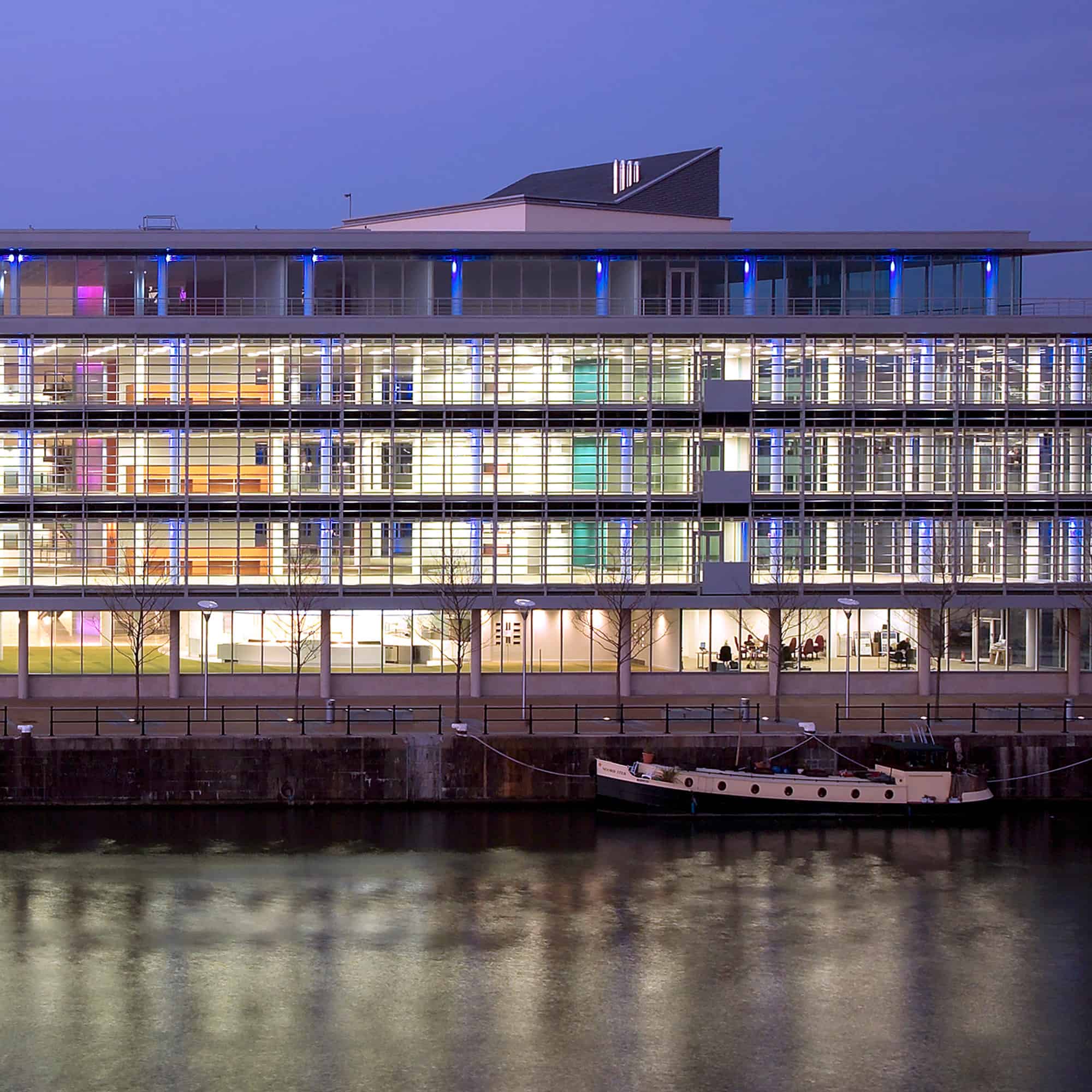
170,000sqft office building which completed the first phase of the regeneration of Canon’s Marsh in the centre of Bristol
Project Details
Collective Team
The shape of the waterfront site was defined by Edward Cullinan Architects’ master plan for the area and the building form evolved from the opportunities and constraints presented by both the site and the master plan, integrated with the principles underlying the efficient design of a modern, flexible working environment.
The solution maximises the amount of floor area available by using space at the corners of the site and responds to central masterplan issues such as key spatial relationships, strategic views and contextual clues.
The opportunity was taken to use the harbour water adjacent to the site as a source of free cooling for the building and to temper incoming fresh air for mechanical ventilation in summer
Environment Agency monitoring data indicated that the floating harbour has ambient water temperatures ranging from 5 degrees Celsius in winter to 15 degrees Celsius in summer. Based on this, it was identified that there are large periods when the water could be used to provide comfort cooling.
During summer, the water temperature is generally in excess of that required to provide free cooling, therefore central cooling plant would be required to supplement the free cooling capacity of the harbour.
Water cooled chillers, twice as efficient as typical air-cooled chillers, could use the harbour water as a heat rejection medium.
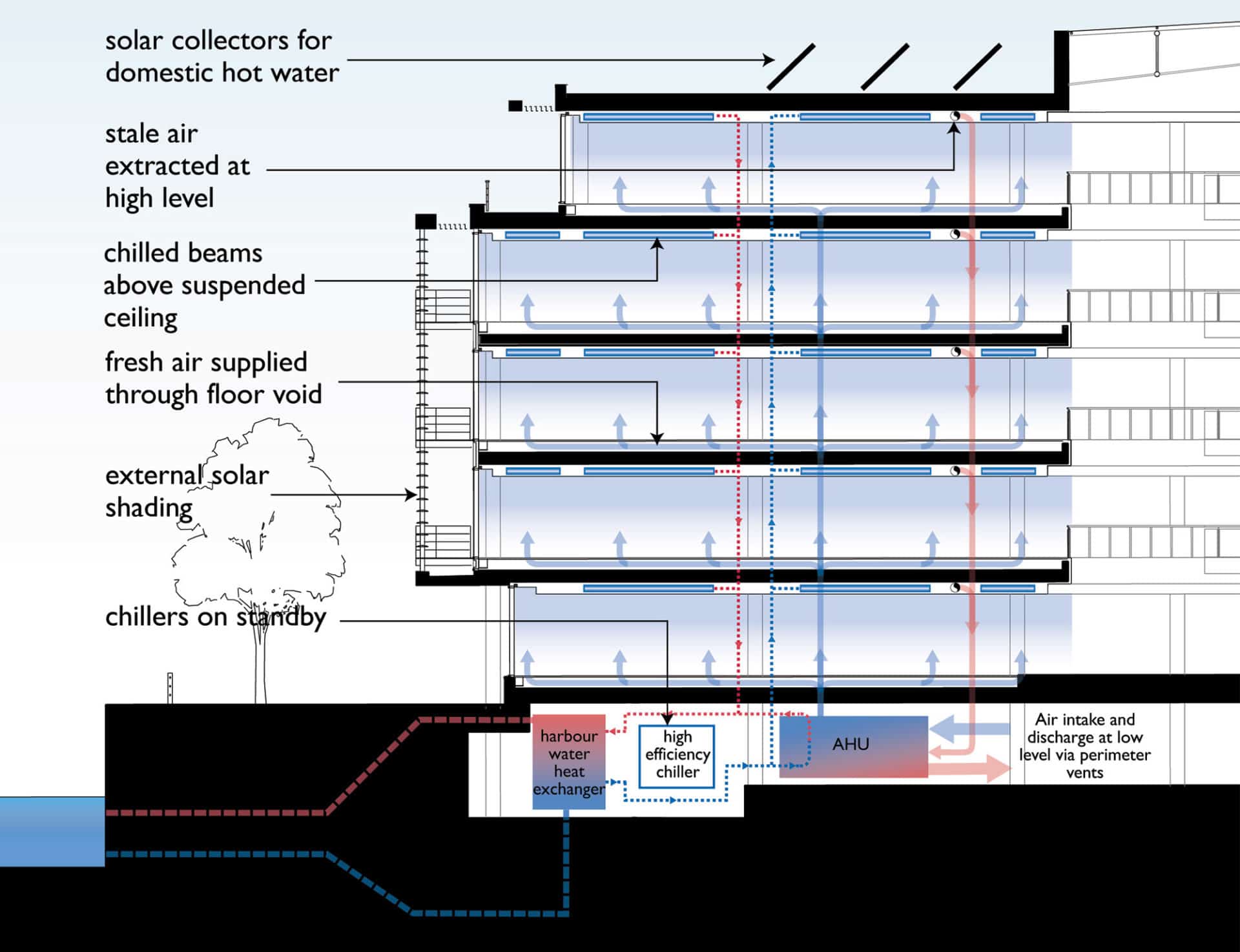 WINTER DAY COOLING Harbour water is abstracted through a grating from the floating harbour into a primary circuit and filtered to remove smaller particulates from the water, before being pumped through sealed parallel plate heat exchangers. Within each heat exchanger, warm secondary return water from the building’s cooling systems is cooled, whilst conversely heating the primary harbour water, without the two streams mixing Once the primary river water has exchanged it’s cooling content and been heated by the secondary return water from the buildings’ cooling systems, it is pumped back into the harbour at a temperature of 4 - 5°C greater than the abstract water temperature The cooled water in the secondary circuit is pumped from the heat exchangers to supply the chilled water cooling system and supply air handling units, where it cools incoming fresh air for the displacement ventilation system. The chilled water circulates through passive chilled beams mounted above a perforated metal suspended ceilings in the office areas. The offices are ventilated using displacement air supplied via floor grilles and cooled by convective airflows driven by the passive chilled beams The chillers remain on standby during this mode of operation
WINTER DAY COOLING Harbour water is abstracted through a grating from the floating harbour into a primary circuit and filtered to remove smaller particulates from the water, before being pumped through sealed parallel plate heat exchangers. Within each heat exchanger, warm secondary return water from the building’s cooling systems is cooled, whilst conversely heating the primary harbour water, without the two streams mixing Once the primary river water has exchanged it’s cooling content and been heated by the secondary return water from the buildings’ cooling systems, it is pumped back into the harbour at a temperature of 4 - 5°C greater than the abstract water temperature The cooled water in the secondary circuit is pumped from the heat exchangers to supply the chilled water cooling system and supply air handling units, where it cools incoming fresh air for the displacement ventilation system. The chilled water circulates through passive chilled beams mounted above a perforated metal suspended ceilings in the office areas. The offices are ventilated using displacement air supplied via floor grilles and cooled by convective airflows driven by the passive chilled beams The chillers remain on standby during this mode of operation
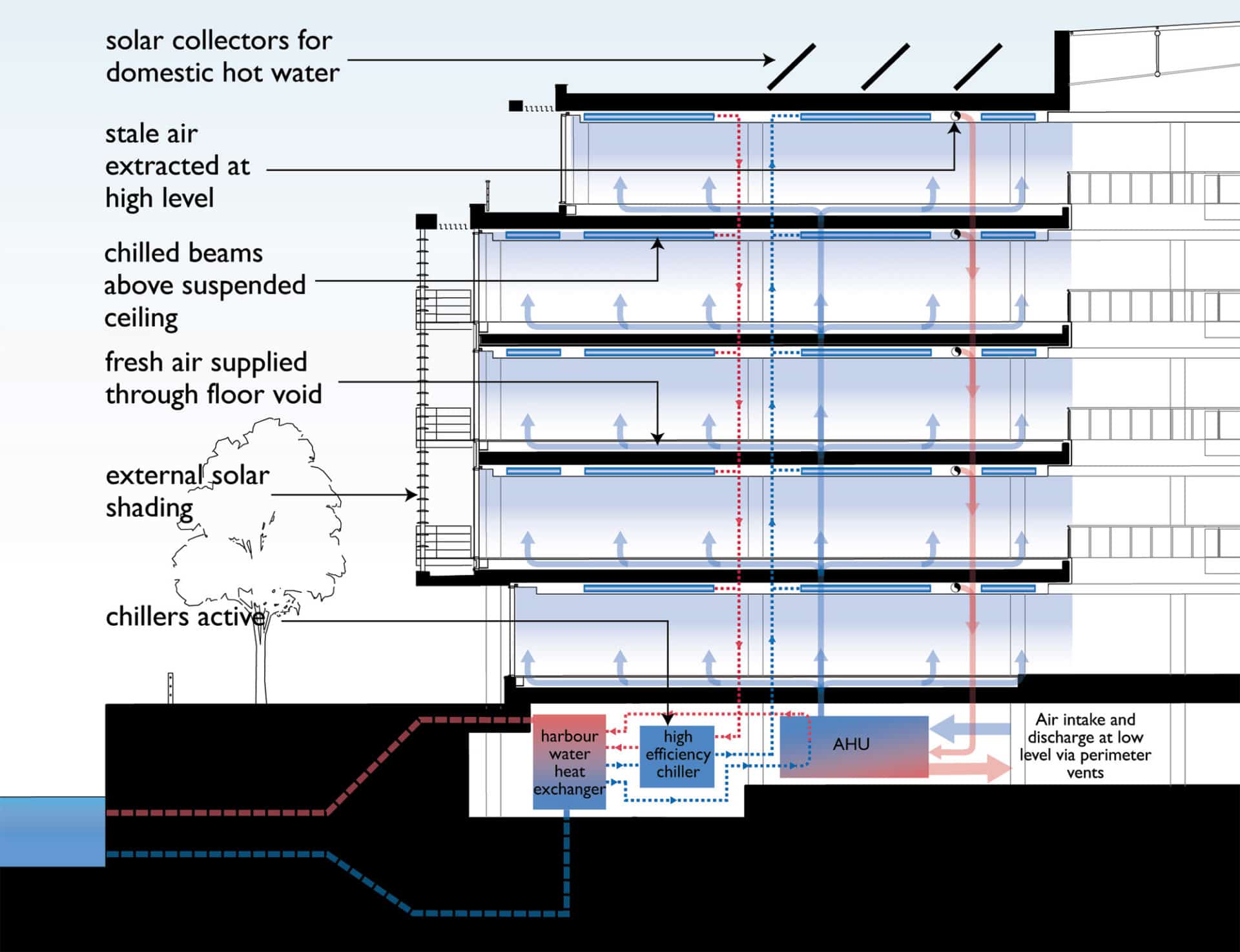 SUMMER DAY COOLING During the summer, the harbour water temperature is generally in excess of the temperature required to provide free cooling, therefore chillers are provided to supplement the cooling capacity of the harbour and provide chilled water for office cooling during the summer peak period Water-cooled chillers have been installed which discharge waste heat to the harbour water via the primary circuit and operate at twice the efficiency of typical air cooled units, requiring less refrigerant and reducing both running costs and emissions Cooled water from the harbour water heat exchangers is used to temper fresh air supplied to the supply air handling units, which feeds the displacement ventilation Night cooling is provided by circulating water cooled by the harbour water through the chilled beams at very low pump power. This dissipates heat gains arising from computers on standby and solar gain during the evening and early morning, and reduces the startup load on the chillers
SUMMER DAY COOLING During the summer, the harbour water temperature is generally in excess of the temperature required to provide free cooling, therefore chillers are provided to supplement the cooling capacity of the harbour and provide chilled water for office cooling during the summer peak period Water-cooled chillers have been installed which discharge waste heat to the harbour water via the primary circuit and operate at twice the efficiency of typical air cooled units, requiring less refrigerant and reducing both running costs and emissions Cooled water from the harbour water heat exchangers is used to temper fresh air supplied to the supply air handling units, which feeds the displacement ventilation Night cooling is provided by circulating water cooled by the harbour water through the chilled beams at very low pump power. This dissipates heat gains arising from computers on standby and solar gain during the evening and early morning, and reduces the startup load on the chillers
Coupled with chilled beams and displacement ventilation, intelligent system controls, solar shading and solar heated hot water, this has enabled the building to achieve a BREEAM ‘Excellent’ rating, reducing running costs and providing a significant contribution to the occupier’s aim of reducing the overall carbon footprint of their business operations
